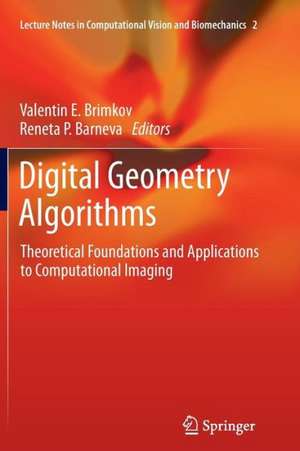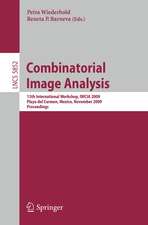Digital Geometry Algorithms: Theoretical Foundations and Applications to Computational Imaging: Lecture Notes in Computational Vision and Biomechanics, cartea 2
Editat de Valentin E. Brimkov, Reneta P. Barnevaen Limba Engleză Paperback – 11 iun 2014
| Toate formatele și edițiile | Preț | Express |
|---|---|---|
| Paperback (1) | 647.40 lei 43-57 zile | |
| SPRINGER NETHERLANDS – 11 iun 2014 | 647.40 lei 43-57 zile | |
| Hardback (1) | 652.31 lei 43-57 zile | |
| SPRINGER NETHERLANDS – 21 mai 2012 | 652.31 lei 43-57 zile |
Din seria Lecture Notes in Computational Vision and Biomechanics
- 15%
 Preț: 651.19 lei
Preț: 651.19 lei - 5%
 Preț: 734.38 lei
Preț: 734.38 lei - 5%
 Preț: 1103.03 lei
Preț: 1103.03 lei - 5%
 Preț: 724.50 lei
Preț: 724.50 lei - 5%
 Preț: 714.63 lei
Preț: 714.63 lei - 20%
 Preț: 344.42 lei
Preț: 344.42 lei - 5%
 Preț: 720.10 lei
Preț: 720.10 lei - 5%
 Preț: 367.64 lei
Preț: 367.64 lei - 5%
 Preț: 731.43 lei
Preț: 731.43 lei - 15%
 Preț: 648.05 lei
Preț: 648.05 lei - 5%
 Preț: 725.07 lei
Preț: 725.07 lei - 5%
 Preț: 374.20 lei
Preț: 374.20 lei - 5%
 Preț: 735.11 lei
Preț: 735.11 lei - 5%
 Preț: 729.42 lei
Preț: 729.42 lei - 5%
 Preț: 1100.30 lei
Preț: 1100.30 lei - 5%
 Preț: 374.57 lei
Preț: 374.57 lei - 15%
 Preț: 642.68 lei
Preț: 642.68 lei - 5%
 Preț: 380.80 lei
Preț: 380.80 lei - 5%
 Preț: 375.70 lei
Preț: 375.70 lei - 24%
 Preț: 888.75 lei
Preț: 888.75 lei -
 Preț: 483.05 lei
Preț: 483.05 lei - 20%
 Preț: 569.86 lei
Preț: 569.86 lei - 15%
 Preț: 652.31 lei
Preț: 652.31 lei - 5%
 Preț: 647.55 lei
Preț: 647.55 lei -
 Preț: 355.15 lei
Preț: 355.15 lei - 18%
 Preț: 971.32 lei
Preț: 971.32 lei -
 Preț: 363.67 lei
Preț: 363.67 lei - 5%
 Preț: 1122.42 lei
Preț: 1122.42 lei - 5%
 Preț: 1168.30 lei
Preț: 1168.30 lei - 5%
 Preț: 1031.90 lei
Preț: 1031.90 lei - 5%
 Preț: 1104.32 lei
Preț: 1104.32 lei - 5%
 Preț: 721.77 lei
Preț: 721.77 lei
Preț: 647.40 lei
Preț vechi: 761.65 lei
-15% Nou
Puncte Express: 971
Preț estimativ în valută:
123.92€ • 134.65$ • 104.16£
123.92€ • 134.65$ • 104.16£
Carte tipărită la comandă
Livrare economică 21 aprilie-05 mai
Preluare comenzi: 021 569.72.76
Specificații
ISBN-13: 9789400799585
ISBN-10: 9400799586
Pagini: 440
Ilustrații: X, 430 p.
Dimensiuni: 155 x 235 x 23 mm
Greutate: 0.61 kg
Ediția:2012
Editura: SPRINGER NETHERLANDS
Colecția Springer
Seria Lecture Notes in Computational Vision and Biomechanics
Locul publicării:Dordrecht, Netherlands
ISBN-10: 9400799586
Pagini: 440
Ilustrații: X, 430 p.
Dimensiuni: 155 x 235 x 23 mm
Greutate: 0.61 kg
Ediția:2012
Editura: SPRINGER NETHERLANDS
Colecția Springer
Seria Lecture Notes in Computational Vision and Biomechanics
Locul publicării:Dordrecht, Netherlands
Public țintă
ResearchCuprins
Preface.- List of Contributors.- Part I General.- 1 Digital Geometry in Image-Based Metrology; Alfred M. Bruckstein.- 2 Provably Robust Simplification of Component Trees of Multidimensional Images; Gabor T. Herman, T. Yung Kong, and Lucas M. Oliveira.- Part II Topology, Transformations.- 3 Discrete Topological Transformations for Image Processing; Michel Couprie and Gilles Bertrand.- 4 Modeling and Manipulating Cell Complexes in Two, Three and Higher Dimensions; Lidija Čomić and Leila De Floriani.- 5 Binarization of Gray-Level Images Based on Skeleton Region Growing; Xiang Bai, Quannan Li, Tianyang Ma, Wenyu Liu, and Longin Jan Latecki.- 6 Topology Preserving Parallel 3D Thinning Algorithms; Kálmán Palágyi, Gábor Németh, and Péter Kardos.- 7 Separable Distance Transformation and its Applications; David Coeurjolly and Antoine Vacavant.- 8 Separability and Tight Enclosure of Point Sets; Peter Veelaert.- Part III Image and Shape Analysis.- Digital Straightness, Circularity, and their Applications to Image Analysis; Partha Bhowmick and Bhargab B. Bhattacharya.- 10 Shape Analysis with Geometric Primitives; Fabien Feschet.- 11 Shape from Silhouettes in Discrete Space; Atsushi Imiya and Kosuke Sato.- 12 Combinatorial Maps for 2D and 3D Image Segmentation; Guillaume Damiand and Alexandre Dupas.- 13 Multigrid Convergence of Discrete Geometric Estimators; David Coeurjolly, Jacques-Olivier Lachaud, and Tristan Roussillon.- Index.
Textul de pe ultima copertă
Digital geometry emerged as an independent discipline in the second half of the last century. It deals with geometric properties of digital objects and is developed with the unambiguous goal to provide rigorous theoretical foundations for devising new advanced approaches and algorithms for various problems of visual computing. Different aspects of digital geometry have been addressed in the literature. This book is the first one that explicitly focuses on the presentation of the most important digital geometry algorithms. Each chapter provides a brief survey on a major research area related to the general volume theme, description and analysis of related fundamental algorithms, as well as new original contributions by the authors. Every chapter contains a section in which interesting open problems are addressed.
Caracteristici
Contains open problems for research projects Provides compact surveys on the specific topics Can be used by both researchers and practitioners Includes supplementary material: sn.pub/extras



























